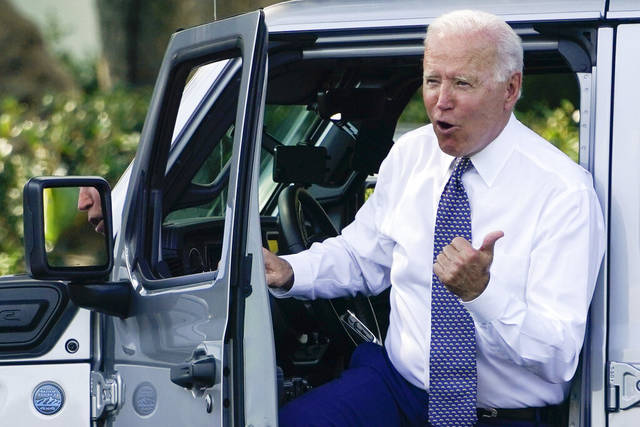Biden, reversing Trump order, announces tougher car pollution standards
WASHINGTON — President Joe Biden introduced plans Thursday to strengthen car pollution standards through 2026, putting the United States on a path to reduce greenhouse gas emissions — though not as quickly as many environmentalists say is needed.
The proposed standards, written by the Environmental Protection Agency and the Transportation Department, would replace significantly weaker Trump-era rules that essentially undid the nation’s biggest climate change initiative. In their place, the Biden administration is offering a compromise that it hopes progressives can live with and automakers can follow.
The president also signed an executive order encouraging automakers to produce more zero-emissions vehicles and setting a new goal of having half of all new cars and trucks be emissions-free by 2030. This would include battery-electric, plug-in hybrid electric and hydrogen fuel cell vehicles.
The future “is electric,” Biden said to supporters gathered on the South Lawn of the White House. “And there’s no turning back. The question is whether we’ll lead or fall behind in the race for the future.”
Gas-powered vehicles are the biggest source of emissions in the U.S., accounting for more than a quarter of the total.@JudyWoodruff & @IAmAmnaNawaz look at new rules, agreements and timelines laid out by the president to try to cut that percentage down. https://t.co/KS5DIvofpZ pic.twitter.com/zJNp8EQ6iI
— PBS NewsHour (@NewsHour) August 5, 2021
Biden’s proposal would tighten pollution standards over a four-year period, beginning with cars coming off the production line in the fall of 2022.
His plan is not expected to cut emissions as significantly as the standards put in place by the Obama administration nearly a decade ago, which required passenger vehicles to achieve an average efficiency of 54.5 miles per gallon by model year 2025. But the new targets would exceed those set under Trump, who weakened the standards to require automakers to achieve an average of about 40 mpg by 2026.
Officials said the new rules would save drivers money at the pump and would decrease consumption of gasoline by about 200 billion gallons over the four years. They estimated the standards would prevent an additional 2 billion metric tons of climate-warming carbon pollution from being released into the atmosphere.
The new rule postpones battles over how much to restrict tailpipe pollution in 2027 and beyond. In the executive order the president signed Thursday, he directed agencies to begin work on the next set of standards.
It remains unclear whether the auto industry will support the newly proposed standards.
John Bozzella, chief executive of the Alliance for Automotive Innovation, an industry lobby group, said in a statement that automakers would work with the administration to evaluate its plan and called on Congress and state legislatures to invest in the infrastructure needed for the adoption of electric vehicles.
In a joint statement, Ford, General Motors and Stellantis — the result of a merger of Fiat Chrysler and the French carmaker PSA — declared their “shared aspiration” to make 40% to 50% of new vehicle sales electric by the end of the decade.
Environmental advocates cheered the Biden administration’s pledge to toss out the Trump regulations, which lowered the standards to a level that automakers had already shown they could achieve it without regulation. But many of those same activists said the administration’s proposed replacement doesn’t go far enough.
Having watched as automakers lobbied Trump to relax the aggressive Obama-era targets, environmentalists are wary of car companies’ promises to gradually phase out the internal combustion engine.
“Today’s proposal relies on unenforceable voluntary commitments from unreliable carmakers to make up to 50% of their fleets electric by 2030,” said Dan Becker, director of the Center for Biological Diversity’s Safe Climate Transport Campaign.
“Global warming is burning forests, roasting the West and worsening storms. Now is not the time to propose weak standards and promise strong ones later,” he said.
Becker and others said that auto companies already have the technology to meet tougher standards than those being proposed by the Biden administration, but that they rarely use it in the United States. Automakers have pushed back, arguing that they’re unable to meet stricter standards because of American consumers’ preference for larger, less fuel-efficient vehicles.
In recent years, some automakers have been able to meet federal standards not by producing fleets of cleaner cars, but by cashing in credits earned by manufacturing a much smaller number of electric vehicles.
The proposed regulations, which have been developed quickly by federal government standards, are a piece of the administration’s broader efforts to push Americans to buy more electric vehicles. Biden has asked Congress for hundreds of billions of dollars to make EVs more affordable through tax credits, to electrify 20% of the nation’s school buses and to build half a million chargers by 2030.
Yet the bipartisan infrastructure bill making its way through Congress accomplishes very little of that. The current deal includes $7.5 billion for electric vehicle charging stations, enough to build just half the number Biden called for.
At stake is the president’s ability to deliver on his promise of eliminating greenhouse gas emissions by 2050 to prevent the worst effects of climate change. Calculating backward, most environmentalists say the only way to meet that goal is to mandate all new cars be emissions-free by 2035.
Remove the ads from your TribLIVE reading experience but still support the journalists who create the content with TribLIVE Ad-Free.

